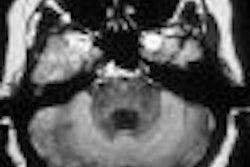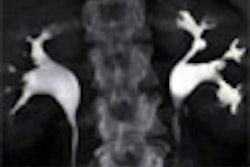(Radiology Review) Radiologists at Duke University Medical Center in Durham, NC, evaluated the role of the Valsalva maneuver during multidetector computed tomography (MDCT) of patients with suspected abdominal wall hernias. Dr. Tracey Jaffe and colleagues scanned 100 patients suspected of having abdominal wall hernia. Their evaluation results were published in the March issue of the American Journal of Roentgenology.
MDCT, using either four-, eight-, or 16-slice imaging, was performed with and without a Valsalva maneuver to "assess for changes in hernia size and contents, and to determine whether the hernia would have been overlooked without a Valsalva maneuver." The specific imaging parameters evaluated included abdominal AP diameter (L5 level); hernia presence, location, and contents; and transverse diameter of the fascial defect.
"With MDCT, the short acquisition time allows imaging of the entire abdomen and pelvis within a single breath-hold including Valsalva maneuver," they stated. MDCT was performed from the level of the dome of the diaphragm to the pubic symphysis one to two hours after patients were given 450 mL of either 2% barium sulfate suspension or dilute meglumine diatrizoate.
IV contrast was given to 73% of patients. "Scans were acquired during the portal venous phase of enhancement, with a delay determined by bolus tracking and automated triggering technology," the authors reported. The contrast administered was adequate for both scans -- at rest and during a Valsalva maneuver.
They determined that half of the 72 hernias diagnosed became more apparent with a Valsalva maneuver, and 10% were only apparent during a Valsalva maneuver. "Hernias became more conspicuous after Valsalva maneuver," and the hernia contents changed as a Valsalva maneuver pushed "small bowel, colon, liver, or fat" through the wall defect. No hernias were diagnosed at rest that were not shown during a Valsalva maneuver.
"A single scan obtained during Valsalva maneuver is sufficient to detect 100% of anterior abdominal wall hernias identified on CT," the authors concluded.
"MDCT of Abdominal Wall Hernias: Is There a Role for Valsalva's Maneuver"?
Jaffe, Tracey A., et al
Department of Radiology, Duke University Medical Center, Box 3808, Durham, NC 27710, USA.
AJR 2005 (March); 184:847-851
By Radiology Review
March 23, 2005
Copyright © 2005 AuntMinnie.com




















